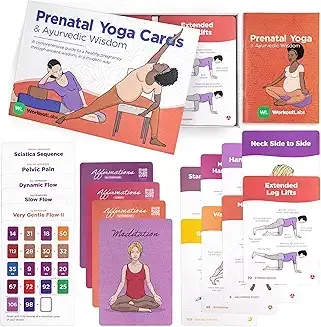The Benefits Of Prenatal Yoga For Pregnancy: A Comprehensive Guide
Table of Contents
- Introduction
- What is Prenatal Yoga?
- Physical Benefits of Prenatal Yoga
- Emotional and Mental Benefits of Prenatal Yoga
- Social and Community Benefits
- How to Get Started with Prenatal Yoga
- Safety Tips for Practicing Prenatal Yoga
- Additional Benefits Supported by Research
- Real-Life Testimonials
- Conclusion

Pregnancy is an incredible journey filled with excitement, anticipation, and transformation. Along with these changes, expectant mothers often seek ways to nurture their physical and emotional well-being during this unique period.
Prenatal yoga emerges as one of the most beneficial practices, providing a wealth of advantages for both mother and baby.
In this article, we will explore the many benefits of prenatal yoga, why it’s highly recommended during pregnancy, and how it can positively impact your journey to motherhood.
Whether you’re new to yoga or looking for a gentle practice tailored to pregnancy, this guide will answer all your questions and provide actionable insights to help you get started.
What Is Prenatal Yoga?
Prenatal yoga is a specialized form of yoga designed to accommodate the physical and emotional changes experienced during pregnancy.
Unlike traditional yoga practices, prenatal yoga focuses on gentle stretching, controlled breathing, and relaxation techniques, all tailored to the needs of expectant mothers.
This practice often includes modified poses that are safe and effective for each trimester. It emphasizes:
- Strengthening the body for childbirth.
- Enhancing flexibility and balance.
- Promoting relaxation and stress reduction.
Why Choose Prenatal Yoga?

Pregnancy can bring a mix of joy and challenges. Prenatal yoga helps expectant mothers navigate this journey with confidence and grace. The following sections highlight the key benefits that make prenatal yoga an essential practice during pregnancy.
Physical Benefits Of Prenatal Yoga
Improved Flexibility and Strength Prenatal yoga includes gentle stretches and poses that target specific muscle groups. This helps improve overall flexibility and build the strength needed to support your growing belly.
Key areas of focus include the lower back, hips, and pelvic floor muscles, which play a vital role during labour and delivery.
Reduced Aches and Pains Many pregnant women experience back pain, sciatica, and joint discomfort as their bodies adapt to pregnancy. Prenatal yoga helps alleviate these issues by:
- Stretching tight muscles.
- Improving posture.
- Enhancing circulation to reduce inflammation.
Enhanced Balance and Stability As your center of gravity shifts, maintaining balance becomes more challenging. Prenatal yoga incorporates poses that improve stability and coordination, helping you feel more grounded and confident as your pregnancy progresses.
Preparation for Labor Prenatal yoga includes poses and exercises that mimic the movements used during childbirth. These prepare your body for labour by:
- Opening the hips.
- Strengthening the pelvic floor.
- Teaching effective breathing techniques for pain management.
Emotional And Mental Benefits Of Prenatal Yoga
Stress Reduction Pregnancy can be an emotional rollercoaster. Prenatal yoga’s focus on mindful breathing and relaxation helps calm the nervous system, reducing stress and anxiety. Studies show that regular prenatal yoga practice can:
- Lower cortisol levels (the stress hormone).
- Promote a sense of well-being and positivity.
Improved Sleep Many expectant mothers struggle with sleep disturbances. Prenatal yoga includes relaxation techniques and gentle stretches that prepare your body and mind for restful sleep. Regular practice can:
- Reduce nighttime discomfort.
- Ease racing thoughts.
Boosted Mood and Emotional Resilience Prenatal yoga promotes the release of endorphins, often referred to as “feel-good” hormones. This can:
- Combat mood swings.
- Foster emotional resilience.
Connection with Your Baby Yoga encourages mindfulness, allowing you to focus on your growing baby and strengthen the maternal bond. Techniques such as mindful breathing and visualization can deepen your connection to your little one.
Social And Community Benefits
Support from Other Moms Prenatal yoga classes often create a supportive community of expectant mothers. Sharing experiences, advice, and encouragement fosters a sense of belonging and understanding during this transformative time.
Guidance from Trained Instructors Certified prenatal yoga instructors provides personalized guidance, ensuring each pose and technique is safe for your stage of pregnancy. This professional support helps:
- Address specific concerns.
- Tailor the practice to your needs.
How To Get Started With Prenatal Yoga
Consult Your Healthcare Provider Before starting any new exercise routine, it’s important to consult your doctor or midwife to ensure prenatal yoga is safe for you, especially if you have a high-risk pregnancy or medical conditions.
Find a Qualified Prenatal Yoga Instructor Look for classes or instructors certified in prenatal yoga. They have specialized training to:
- Modify poses for each trimester.
- Ensure your safety and comfort.
Gather the Right Equipment Basic items include:
- A yoga mat.
- Comfortable, breathable clothing.
- Props like bolsters, blocks, and straps for added support.
Start with Gentle Poses Begin with beginner-friendly poses and gradually progress as your body adapts. Key poses for pregnancy include:
- Cat-Cow Pose: Relieves back tension and improves spinal flexibility.
- Bound Angle Pose: Opens the hips and stretches the inner thighs.
- Child’s Pose: Promotes relaxation and stretches the lower back.
Practice Regularly Aim for 2-3 sessions per week, adjusting frequency based on your energy levels and schedule.
Safety Tips For Practicing Prenatal Yoga
Listen to Your Body Pay attention to your body’s signals. Avoid poses that cause discomfort or strain.
Avoid Certain Movements Skip poses that involve:
- Deep twists.
- Lying flat on your back after the first trimester.
- Intense forward bends or inversions.
Stay Hydrated Keep a water bottle nearby to stay hydrated during your practice.
Focus on Breathing Use deep, controlled breathing to enhance relaxation and oxygen flow.
Additional Benefits Supported By Research
Reduced Risk of Complications Studies suggest that prenatal yoga may lower the risk of preterm labour, gestational diabetes, and hypertension by promoting overall health and stress management.
Shorter Labor and Easier Delivery Women who practice prenatal yoga often report shorter labour times and reduced need for medical interventions, thanks to their improved physical and mental preparation.
Postpartum Recovery Prenatal yoga strengthens the core and pelvic floor, aiding faster recovery after childbirth. It also instils habits that can transition into postnatal yoga for continued benefits.
Real-Life Testimonials
Many women have shared their positive experiences with prenatal yoga, highlighting its transformative effects on their pregnancies. Here’s what some mothers had to say:
- “Prenatal yoga became my sanctuary during pregnancy. It helped me manage back pain and gave me tools to stay calm during labour.”
- “I connected with other moms in my yoga class, which made the experience even more special. It was a place to share, learn, and grow together.”
Conclusion: Embrace The Benefits Of Prenatal Yoga
Prenatal yoga offers a holistic approach to nurturing your body, mind, and spirit during pregnancy. From physical strength and flexibility to emotional resilience and stress relief, the benefits are vast and well-documented.
By integrating this gentle practice into your routine, you’re not only enhancing your well-being but also fostering a healthier environment for your baby.
Whether you’re a seasoned yogi or new to the practice, prenatal yoga is a powerful tool to support you through pregnancy and beyond. Take the first step by finding a class near you or exploring online resources, and enjoy the incredible journey of motherhood with greater ease and confidence.
Additional Resources
For further guidance and information, you can explore these trusted resources:
- American Pregnancy Association: Prenatal Yoga
- Yoga Journal’s Guide to Prenatal Yoga
- Mayo Clinic: Prenatal Yoga Benefits
These websites provide additional insights, tips, and expert recommendations to help you make the most of your prenatal yoga journey.
People Also Asked Section
What is the best time to start prenatal yoga during pregnancy?
Prenatal yoga can usually be started after the first trimester. Consult your doctor for personalized advice.
Is prenatal yoga safe for high-risk pregnancies?
It depends on your specific condition. Always consult your healthcare provider before starting prenatal yoga.
Can prenatal yoga help with labour pain?
Yes, prenatal yoga prepares the body and mind for labour by teaching pain management techniques and improving flexibility.
What should I wear to a prenatal yoga class?
Wear comfortable, stretchy clothing that allows free movement, such as yoga leggings and a breathable top.
How often should I practice prenatal yoga?
Practicing 2–3 times a week is ideal, but this can vary based on your energy levels and stage of pregnancy.
What are the best prenatal yoga poses for back pain?
Cat-Cow Pose, Child’s Pose, and Pelvic Tilts are effective for relieving back pain.
Can I practice prenatal yoga at home?
Yes, many online classes and tutorials are available for safe, guided home practice.
What are the mental health benefits of prenatal yoga?
Prenatal yoga reduces stress, improves sleep, and enhances emotional resilience.
Is prenatal yoga suitable for beginners?
Absolutely! Prenatal yoga is gentle and designed for all fitness levels, including beginners.
Can prenatal yoga improve postpartum recovery?
Yes, it strengthens the pelvic floor and core, aiding faster recovery post-delivery.






